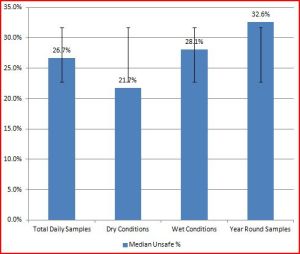Results of recent private well-testing in Kewaunee County show over one in five wells are unsafe, testing positive for E Coli, Coliform, and Nitrates. The tests were conducted by a state-certified lab at the Kewaunee County Land and Water Conservation Department, and demonstrate a failure on the part of the DNR to protect the people of Kewaunee County and their water.
The Wisconsin Department of Natural Resources (DNR) has always protected the water we rely on for our very lives. Today, there is strong evidence that the DNR is failing the people of Kewaunee County, leaving the area’s water quality and availability to the whims of powerful corporate agriculture and factory farm interests.
Recent tests conducted on private wells in Kewaunee County show that 15% of wells tested positive for coliform, over 35% tested positive for elevated nitrate levels (12% tested higher than 10 ppm, considered unfit for any human consumption), and 22% were considered “unsafe” due to bacterial or nitrate contamination.
The well tests provide a snapshot in time for a set of wells on an annual basis, usually in the Spring or Fall. The testing has been ongoing since 2004. The full spreadsheet can be found at this link: Kewaunee Well Data
Forward Institute derived median levels of contamination from the nine years of testing data (from the Kewaunee County Land and Water Conservation Department) stratifying for weather conditions, which showed the recent test results to be consistent with the median levels. Of note is that under dry conditions, the percentage of unsafe wells is below the standard deviation, implying that runoff of applied manure is playing a significant role in the contamination. Also noteworthy is the absence of E coli under dry conditions. Under wet conditions, contamination levels increase, particularly E coli. Year-round random tests reported higher than the standard deviation of unsafe wells, implying that a larger random-sample, year-round study should be conducted to better understand the impact on local wells.
Wisconsin has laws that protect our water, and the DNR is looking the other way. Meanwhile, evidence continues to grow that factory farms contribute to contaminating what is a life necessity – water. Additional study and research on the impact of factory farm expansion on water and health should be required before additional permits are approved by the DNR.
Figure 1. Median Wells Testing Unsafe 8/2004 – 3/2013, Stratified by Total Sample, Weather Conditions, and Year-Round Point Samples.
Note: Vertical bars represent one standard deviation from the median of Total Daily Samples.
Table 1. Median Wells Testing Unsafe as Percent and Number.
|
Total Tested |
Median Tested |
Median Unsafe |
Median Unsafe % |
|
|
Total Daily Samples |
630 |
50.5 |
15.5 |
26.7% |
|
Dry Conditions |
101 |
31 |
5 |
21.7% |
|
Wet Conditions |
529 |
56 |
17 |
28.1% |
|
Year Round Samples |
86 |
86 |
28 |
32.6% |
A Forward Institute posting from March examined the health concerns surrounding livestock density and the associated health risks, based on a Johns Hopkins study from early 2013.

